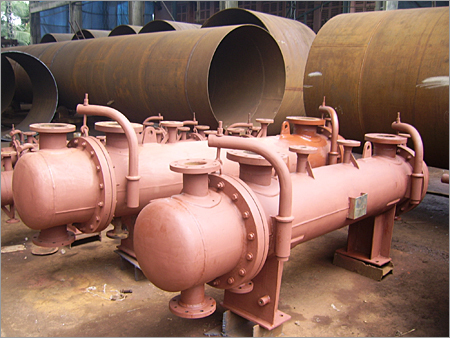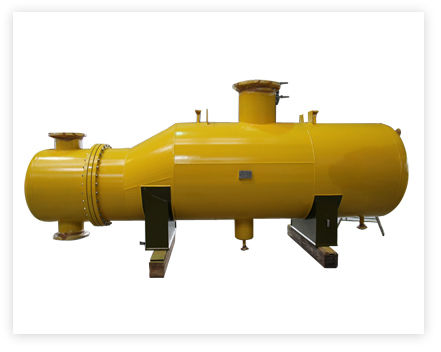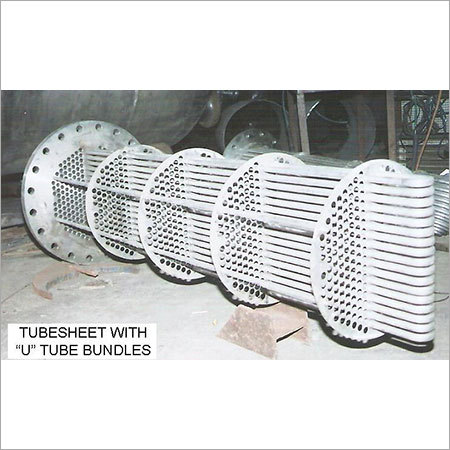Double Pipe Heat Exchanger
Product Details:
Double Pipe Heat Exchanger Price And Quantity
- 1 Unit
- 100000 INR/Unit
Double Pipe Heat Exchanger Trade Information
- 2-5 Unit Per Month
- 4-8 Week
Product Description
Heat ExchangersIdeally Heat Exchanger is a device constructed for proficient heat transfer from one medium to another. For providing immunity from mixing or direct contact, the media may be separated by a solid wall. They are broadly used in space heating, air conditioning, refrigeration, chemical plants, petrochemical plants, power plants, petroleum refineries, sewage treatment and natural gas processing. One general example of a heat exchanger is the radiator in a car, wherein the source heat, being the hot engine-cooling fluid, water, transmits heat to air flowing through the radiator (i.e. the heat transfer medium).
We are manufacturing optimum quality stainless heat exchangers that made with SS304 or SS316 grade steels. These stainless steel heat exchangers are built with TIG welding and mirror or dull buffing finish. Required for special applications, our offered heat changers are durable and anti-corrosive in nature. The categorization is done according to the flow arrangements of heat exchangers which are especially designed to optimize the wall surface area between the two fluids and minimize hindrance to fluid flowing through the exchanger. Manufactured in different technical specifications, heat exchanger is used for a wide range of applications.
Our Others Heat Exchangers
Shell and Tube Heat Exchanger
Shell And Tube Heat Exchanger in different technical specifications is possibly the most extensive and commonly used basic heat exchanger model in the process industries. There are plenty of reasons for its popularity in the industry. The shell and tube heat exchanger offers a relatively large ratio of heat transfer area to volume and weight. It has its surface in specific shape which is comparatively easy to fabricate in a broad spectrum of sizes and which is technically sturdy enough to endure common shop fabrication stresses, normal operation conditions, and shipping and field erection stresses. There are several modifications to the basic configuration that can be used to solve specific problems.
The shell and tube heat exchanger has the advantage of easy cleaning and convenient replacement of components like gasket and tubes which are subjected to frequent failures. Finally, good design method exists, and shop facilities and expertise for successful design development and production of shell and tube heat exchanger are available. Varied number of passes can also be provided contingent on the size and requirement of the Heat exchanger. Shell heat exchanger and tube type heat exchangers are designed and constructed to cater to the varied requirements of different industries. These are manufactured using high grade raw material including SS 304, SS 316 and SS 316L grades of stainless steel and are extensively used in chemicals, food and dairy, and pharmaceutical industries. Apart from this we also design and manufacture tube heat exchangers shell heat exchangers, which comprises a series of tubes, through which one of the fluids runs. The second fluid runs over the tubes to be heated or cooled. The tubes can be arranged as per customers’ needs.
Double Pipe Heat Exchanger
Double Pipe Heat Exchangers are considered as the simplest heat exchangers used in different industries. On the one hand, these heat exchangers are less expensive for both production and maintenance that makes them a good choice for small industries. On the other hand, low efficiency apart from more space acquired for these exchangers in large scales, has necessitated the use of more efficient heat exchanger like shell and tube in the modern industries. Nevertheless the simple design of double pipe heat exchangers make it ideal for teaching the basics of heat exchanger design to students. Since the fundamental rules for modern and normal heat exchangers are the same, students can grasp the design techniques quickly. To begin with the design of a double pipe heat exchanger, the first step is to determine the heat duty of the heat exchanger. It should be noted that for simpler design, it’s better to ignore heat loss in heat exchanger for basic design. The heat duty is defined as the heat gained by cold fluid which is equivalent to the heat loss of the hot fluid.
Kettle Reboiler
Kettle Reboilers (Image 1) are very simple and dependable. They may need pumping of the column bottoms liquid into the kettle, or there may be adequate liquid head to convey the liquid into the reboiler. In this device, steam flows through the tube bundle and flows out as condensate. The liquid from the bottom of the tower, generally known as the bottoms, flows through the shell side. There is a containing wall or overflow block separating the tube bundle from the reboiler segment where the residual reboiled liquid (called the bottoms product) is taken back, so that the tube bundle is left covered with liquid and lower the quantity of low-boiling compounds in the bottoms product.
Material of Construction (MOC) Offered : - CS (IS 2062 Gr A/B, SA 516 Gr 60/70, BQ), SS 316, SS 304, SS 316 L, SS 304 L. SS 310, MONEL, TITANIUM, INCONEL, HASTALLOY, ETC.
Plate Heat Exchanger
Another kind of heat exchanger is the plate heat exchanger. Such heat exchangers are made of multiple, thin, slightly separated plates having very large surface areas and fluid flow passages for heat transfer. This stacked-plate arrangement can be more functional, in a particular space, than the shell and tube heat exchanger. Advancement in gasket and brazing technology has made the plate-type heat exchanger progressively more practical. In HVAC applications, such type of large heat exchangers are called plate-and-frame; when used in open loops, the heat exchangers normally function as gasket type to allow intermittent disassembly, inspection and cleaning. There are several types of eternally bonded plate heat exchangers, like vacuum-brazed, dip-brazed, and c plate varieties, and they are often assigned for closed-loop applications such as in refrigeration. Plate heat exchangers also vary in the kinds of plates used, and in the configurations of those plates. Some plates may possess the mark of "chevron", dimpled, or other patterns, while others may have machined fins and/or grooves.

Price:
- 50
- 100
- 200
- 250
- 500
- 1000+








